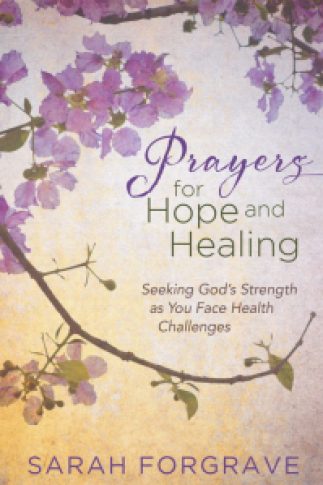How to Pray When You Don’t Know What to Say
“How to Pray When You Don’t Know What to Say” is a blog post by Sarah Forgrave (www.sarahforgrave.com), an introduction to her new book Prayers for Hope and Healing. I read Sarah’s article when she guest posted on Debbie W. Wilson’s Refreshing Faith website.
What caught my attention immediately was Sarah’s reference to her long-time approach to prayer; it was very much like what I’ve written about in my book Brokenness to Beauty, the ACTS in prayer which was so beneficial to me when I discovered it.
Here’s what I wrote in Brokenness to Beauty, Chapter 11 “Prayer: Just Do It … But How?”:
“I distinctly remember when, as a college student, I cried out … in frustration to God. My ‘prayer life’ wasn’t working. I would make my prayer list and start my prayers by asking God this and that for so-and-so, and I meant it wholeheartedly. This would last for a day or two, but time after time my fervor would dwindle into mechanical words read from a list. I knew I had to pray with my heart, but I didn’t know how to maintain the transfer from my head to my heart. I sincerely yearned to communicate with God and effect change through prayer on behalf of others in need, yet I usually ended up feeling that I was falling short. I didn’t know what to do about it, so I did the only thing I did know to do: I asked God to help me.
A few years later I was introduced to a simple way of entering into God’s presence in prayer, one that’s easy to remember and rooted in the Scriptures. It changed the way I prayed and as a result, changed my life. It is called the ACTS of prayer.[i]
The acrostic stands for:
Adoration. Approach God in humility, reverence, and awe, and worship him for who he is. We learn about him as we read and study the Bible. He is holy, and we must approach him as such (Luke 11:2).
Confession. Sin acts as a wall between us and God, effectively blocking our prayers (Isaiah 59:2). We need to be sensitive to God’s Spirit on a daily basis as he speaks conviction to us, confessing and repenting of all known sin as soon as we are aware of it. That way, communication with God remains open (1 John 1:8–9).
Thanksgiving. The greatest acceptable sacrifice we can make to God (along with laying our lives at his feet as a living sacrifice, as Paul tells us to do in Romans 12:1) is the sacrifice of thanksgiving and praise (Hebrews 13:15). Our prayers are to be seasoned with gratitude.
Supplication. This is the part we normally think of as prayer: asking God for something (Luke 11:9–10). Our requests must be couched in the reverence and worship due to God as we seek first his will in the matter, with our prayer purged of known sin through confession and repentance, wrapped in trust, and infused with thanksgiving.”
As I wrote, “It changed the way I prayed and as a result, changed my life.” It became the pattern for most of my prayers. When I read Sarah’s article, it seemed she used a similar way of praying.
But I also wrote in Brokenness to Beauty, “There are, of course, times when all we can do is burst out, ‘Lord help me!'” There are times when we are so burdened and feel so deeply our need, we cry out like the psalmists did, in the agony of our heart. We still approach God in humility and reverence, but we burst into his presence in the agony of our situation.
I think this is what Sarah found as well when she experienced tremendous physical struggles coping with a chronic disease, and she found prayer too was a struggle. Her method of approaching God felt insufficient in her time of need.
I understand fully, having lived with a chronic disease for over 50 years and having faced the trauma of breast cancer and treatment, and then the fractures of both my femurs, rods surgically implanted in them, and months of physical therapy. Life gets hard at times and what is familiar can seem inadequate for the present struggle.
That’s why I want to share Sarah’s blog post with you and introduce you to her book, Prayers for Hope and Healing. If you are struggling right now, or know someone who is, and prayer seems just as hard, the old familiar patterns inadequate, this article and Sarah’s book may be just what you need.

From the back cover of Prayers for Hope and Healing:
Amid Pain and Weakness…There is HOPE
Serious or chronic medical issues bring a litany of painful and confusing feelings that only someone else who’s been in a similar situation could possibly understand. Sarah Forgrave has walked the difficult road you find yourself on. And she empathizes with the uncertain future you face.
No matter the road ahead, you don’t have to face it alone. Even in the depths of your worst emotional and physical pain, God is right there beside you, offering His comfort, love, and peace.
As you read these heartfelt prayers and devotions, let this book be your manual to help navigate the difficult set of emotions that come with health issues. Read it front to back or go directly to the devotion addressing how you feel at any given moment…when you need it the most.
Above all, know that you are never, ever alone.
Read Sarah’s blog post as she shares “How to Pray When You Don’t Know What to Say”:
For most of my life, I approached prayer like a checklist. It went something like this. Adore God. Confess my sins. Thank Him for His forgiveness. Ask Him for what I want.
This checklist helped fill the awkward silence, but when life got hard, so did prayer.
Suddenly my adoration wasn’t so quick to rise to the surface. Instead of confession and gratitude, I was mad at God for letting me hurt. There were plenty of things I wanted Him to do, but I frankly didn’t have much faith He would follow through on them.
Have you found yourself in the same place?
To continue to read how Sarah learned to connect with God during hard times, you can see the full article here: https://debbiewwilson.com/how-to-pray/
Bio:
Sarah Forgrave is an author and wellness coach who loves inspiring others toward their full potential. In addition to her book, Prayers for Hope and Healing (Harvest House, October 2017), her writing credits include contributions to The Gift of Friendship, Guideposts’ A Cup of Christmas Cheer, and the webzine Ungrind. When she’s not writing or teaching, she loves to shop at Trader Joe’s or spend time with her husband and two children in their Midwest home. Visit Sarah at www.sarahforgrave.com, or at the following sites:
Facebook: www.facebook.com/AuthorSarahForgrave
Pinterest: www.pinterest.com/SarahForgrave
Instagram: www.instagram.com/SarahForgrave_Author
Twitter: www.twitter.com/SarahForgrave
[i] The ACTS of Prayer are explained at
http://prayercentral.net/engage-me/ways-to-pray/pray-with-acts
